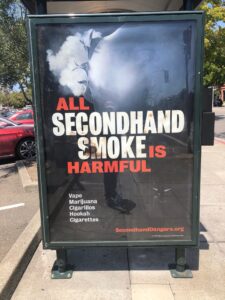UPDATE 5/23 – States That Legalize Marijuana See Reduced Tobacco Use, Study Finds
The California Department of Public Health has undertaken a busboard campaign claiming that marijuana and vapes produce similar second-hand smoking dangers as tobacco. The ads reference a TobaccoFreeCA webpage warning that secondhand marijuana smoke is cancer-causing and harmful to the brain, lungs, and heart. A subpage titled, “Exposure to Secondhand Smoke from Marijuana is Dangerous,” is dated June 19, 2020.
Starting with Prop. 99 in 1998, and continuing with Prop. 56 in 2016, Californians voted to add a substantial tax ($2.87) to each pack of cigarettes sold in our state, with the monies recouped earmarked specifically for public health and tobacco education efforts. Both initiatives were targeted specifically at tobacco smoking, a known cause of disease both in users and second-hand bystanders.
However, tobacco tax money is now being misused to lump cannabis and vapes along with tobacco smoking, despite a glaring lack of scientific evidence that they pose comparable dangers to public health. At the state and local levels, lawmakers are pushing anti-cannabis and vape legislation, with support of CDPH and the well-funded anti-tobacco lobby, which receives grants from CA’s tobacco tax. In FY 2017/18, $178.5 million was allocated to the DPH Tobacco Control Board for their anti-tobacco-smoking efforts.
Guidance issued on August 20, 2019 by the CDPH’s Tobacco Education and Research Oversight Committee (TEROC) states, “It is important for tobacco control programs to make it clear to the public that smoke is smoke. Both tobacco and marijuana produce secondhand smoke and both are associated with adverse health outcomes.”
CAL NORML LOOKS AT THE SCIENCE
UPDATE 3/2023: A study by Ott, Zhao et al. at Stanford University funded by CA’s Tobacco Related-Disease Research Program (TRDRP), measures PM2.5 (2.5 micrometer particulate) emissions from various forms of cannabis smoking or vaporizing vs. cigarettes. PM2.5 particulates are commonly linked to lung disease, but their toxicity depends on their chemical composition. If, as is commonly the case, they come from combusted hydrocarbons like auto and truck emissions, then they are indeed full of respiratory toxins like benzene, etc. If, on the other hand, they come from vape liquids, they are commonly benign. As for smoke particulates, we know from human studies that tobacco smoke causes lung cancer, emphysema, etc., whereas marijuana smoke doesn’t. Evidently the toxicity of the PM2.5s from tobacco is greater than for cannabis.
The TRDRP, which “transforms tobacco taxes into cutting edge research to reduce commercial tobacco use and tobacco-related diseases and to inform public policy that benefits California’s diverse populations,” has included in its call for grant proposals (due 2/23/23) the following:
• Protection of youth from tobacco and cannabis exposure
• Tobacco policy interactions with cannabis policy
• Protection of nonsmokers from secondhand nicotine or cannabis smoke or aerosol
Following is an examination of the scientific studies cited at the CDPH site claiming “Exposure to Secondhand Marijuana Smoke Is Dangerous.” On careful analysis, they fail to support the claim that secondhand marijuana smoke or vapes pose a significant danger to public health like tobacco smoke.
CLAIM #1: Regardless of the name, secondhand smoke from marijuana is dangerous for people exposed to it, especially children.”
PURPORTED EVIDENCE #1 • Wilson KM, Torok MR, Wei B, et al. Marijuana and Tobacco Coexposure in Hospitalized Children. Pediatrics. 2018;142(6):e20180820. doi: 10.1542/peds.2018-0820.
This study simply documents that cannabinoids are frequently found in the urine of children whose parents are heavy tobacco smokers. All of the subjects’ parents were enrolled in tobacco smoking cessation programs, but many also used marijuana. Out of 83 children examined, 45.8% had detectable THC-COOH in urine; 8% had CBD and 10.8% THC. There was no evidence of any harm to the children. The tests were extremely sensitive: mean level of THC for those with detectable metabolites was 0.02 ng/ml, a negligible amount. THC-COOH is an inactive metabolite and CBD is not psychoactive.
• EVIDENCE #2 Willis AL, Moss A, Torok M, Lowary M, Klein JD, Wilson KM. Smoke Exposure, Cytokine Levels, and Asthma Visits in Children Hospitalized for Bronchiolitis. Hosp Pediatr. 2019;9(1):46-50. doi: 10.1542/hpeds.2018-0067
This study examined 98 children hospitalized for bronchiolitis. Their principal finding was that elevated cytokine levels elevated the risk of a return visit for asthma. Only seven subjects reported exposure to marijuana, and there was no statistically significant relationship between marijuana smoke exposure and visits for asthma. The study did find that MJ-exposed patients had lower levels of the TNF-a cytokine, but the consequences of this are unclear. Significantly, there was no association between tobacco exposure and return visits for asthma or cytokine levels. If anything, this paper vindicates secondhand smoke—but the number of subjects is so minuscule as to make the results meaningless.
CONCLUSION: The cited evidence fails to support the assertion that secondhand marijuana exposure is “dangerous,” for children or otherwise. It shows no harm.
CLAIM #2: Marijuana smoke “has significantly higher amounts of toxic chemicals such as tar and ammonia, and more than twice the amount of hydrogen cyanide, an extremely poisonous chemical.”
• EVIDENCE #1 OEHHA Assessment of Carcinogenicity of MJ Smoke (2009).
OEHHA is correct in claiming that carcinogens exist in marijuana smoke, obliging them to put it on the Prop. 65 list of carcinogens. However, OEHHA does not bother to assess whether the quantities are sufficient to pose an actual human health hazard. Similar carcinogens occur in smoke from kitchens, fireplaces, candles and barbecues, as well as ambient air pollution. The crucial question is: are the levels high enough to pose an actual health risk to humans? In fact, actual human studies of chronic marijuana users have failed to find any increased risk of smoking-related cancers, according to a comprehensive 2017 review by the National Academy of Science[1]. It is therefore even less likely that second-hand marijuana smoke poses cancer risks
• EVIDENCE #2 Moir D, Rickert WS, Levasseur G, et al. Comparison of Mainstream and Sidestream Marijuana and Tobacco Cigarette Smoke Produced under Two Machine Smoking Conditions. Chem Res Toxicol. 2008;21(2):494-502
This and other studies have shown chemical similarities between tobacco and marijuana smoke. Among the hundreds of chemicals in smoke, this study reported that marijuana had higher levels of hydrogen cyanide, ammonia, nitric oxides, and certain aromatic amines than tobacco smoke. But once again, the question is whether the actual quantities involved were significant to human health. Regarding hydrogen cyanide (HCN), despite the scare-mongering language of TobaccoFreeCA, it is harmless at the low levels encountered in non-occupational settings. HCN is commonly found in fruit pits, vehicle exhaust, and combustion emissions. No poisonings from HCN are known to occur in tobacco or cannabis smokers.
CONCLUSION: True, but irrelevant in absence of evidence of human toxicity at ambient trace levels in secondhand smoke. In general, smokers consume much smaller quantities of marijuana than tobacco (a typical joint is equal to about half a cigarette, and regular users typically smoke a couple of joints per day, versus 20 a day in a pack of tobacco cigarettes). The hazards of secondhand exposure are therefore correspondingly lower for marijuana.
CLAIM #3: “Secondhand smoke associated with adverse cardiovascular effects like hardening and narrowing of the arteries which could lead to heart attack and stroke.”
EVIDENCE • Wang X, Derakhshandeh R, Liu J, et al. One Minute of Marijuana Secondhand Smoke Exposure Substantially Impairs Vascular Endothelial Function. J Am Heart Assoc. 2016
This study in rats showed impaired endothelial function in femoral arteries for 90 min after exposure. No measure of long-term effects.
CONCLUSION: One laboratory rat study does not constitute evidence of human harm. On the contrary, several recent human studies have found that first-hand use of marijuana is not associated with atherosclerosis, stroke or cardiovascular disease [2][3][4][5] – much less second-hand exposure.
CLAIM #4: “Secondhand MJ smoke produces a secondhand high with detectable levels of THC…found in their blood and urine.”
EVIDENCE #1 • Cone EJ, Bigelow GE, Herrmann ES, et al. Non-smoker exposure to secondhand cannabis smoke. I. Urine screening and confirmation results. J Anal Toxicol. 2015
A familiar study. Extreme conditions (no ventilation, lots of smoke) were necessary to show low-level urine positives. No measurement of THC, just inactive urine metabolites. Ventilation substantially reduced levels.
EVIDENCE #2 • Holitzki H, Dowsett LE, Spackman E, Noseworthy T, Clement F. Health effects of exposure to second- and third-hand marijuana smoke: a systematic review. CMAJ Open. 2017;5(4):E814-E822
Useful, comprehensive review of 15 best secondhand marijuana smoke studies. A couple of them found low blood levels of THC <2 ng/ml for a short while after exposure, far less than the 100+ ng/ml reading necessary to get a high. A handful of study subjects reported mild effects which were interpreted as “contact highs.” Ventilation greatly reduced effects.
CONCLUSION: True, but only in extreme circumstances with heavy exposure and no ventilation. Not relevant to smoke from neighboring apartments.
CLAIM #5: Nonsmokers exposed to marijuana secondhand smoke in a room without ventilation tested positive for THC for up to three hours following exposure.
EVIDENCE • Herrmann ES, Cone EJ, Mitchell JM, et al. Non-smoker exposure to secondhand cannabis smoke II: Effect of room ventilation on the physiological, subjective, and behavioral/cognitive effects. Drug Alcohol Depend. 2015;151:194-202.
The abstract says: “Under extreme, unventilated conditions, secondhand cannabis smoke exposure can produce detectable levels of THC in blood and urine, minor physiological and subjective drug effects, and minor impairment on a task requiring psychomotor ability and working memory….room ventilation has a pronounced effect.”
CONCLUSION: True again, but only in extreme conditions not relevant to smoke from neighboring rooms or apartments.
VAPORIZING – A SAFER ALTERNATIVE
The TobaccoFreeCA busboards misleadingly list vapes as a secondhand smoking danger along with cigarettes. In fact, vaporizers don’t emit smoke at all. Smoke is defined as the “airborne particulates and gases given emitted when a material undergoes combustion or pyrolysis” (Wikipedia.org). Combustion of carbon heats the leaf to temperatures above 1000°F, which results in hundreds of chemical byproducts, including carcinogenic tars, particulates and toxic gases such as HCN. Vaporizers operate at lower temperatures where combustion doesn’t occur, thereby suppressing toxic smoke byproducts. Instead, they emit a relatively pure chemical vapor stream of active cannabinoids and terpenes (in the case of marijuana), or nicotine (in the case of tobacco). (Some vape fluids include additives to promote vaporization. The recent outbreak of EVALI lung disease was linked to Vitamin E acetate, a toxic additive used to dilute THC in illegal, black market cannabis e-cigs.)
Numerous studies have shown that vaporizers – properly manufactured, of course – are far safer than smoking:
- Lab studies sponsored by Cal NORML found that herbal vaporizers effectively eliminate noxious toxins from marijuana smoke, delivering a purified stream of medically active ingredients [6].
- A study of a THC vape pen found the health hazard from vaped cannabis was less than 1/1000 that of smoking [7]. The hazards of second-hand vapor would thus seem all the more negligible.
- Similar results have been reported with nicotine e-cigs, which operate on the same principle [8], [9]. British public health authorities estimate that vapes are 95% safer than smoking, and are accordingly promoting them as a harm reduction alternative to cigarettes [10].
- Vaporizers have other important advantages. Unlike cigarettes, which constantly spew out side-stream smoke, they operate only when the user is inhaling, thereby greatly reducing secondhand exposure. Vaporizers likewise eliminate sparks, embers, and ashes, and don’t require lighters or matches.
Cal NORML has long recommended that cannabis consumers switch from smoking to vaporization, especially patients with respiratory problems. Unfortunately, however, California has tended to lump vaporization with smoking.
CONCLUSION
In light of the evidence, it is highly perverse that CA DPH and TobaccoFreeCA have mounted a scare campaign to portray secondhand vaping—and marijuana vaping in particular—as a health hazard comparable to cigarettes. The evidence is overwhelming that vaping presents far lesser risks than smoking, and secondhand vapor even less so. It is likewise clear that the risks of marijuana smoking are substantially less than those of tobacco, and the second-hand risks even more so.
It is regrettable that CA DPH and TobaccoFreeCA have strayed so far from the intent of the tobacco tax initiatives Prop. 99 and Prop. 56. Unlike tobacco, cannabis has never been shown to present an appreciable public health risk to bystanders. Unlike tobacco, cannabis also has legally recognized medical benefits. California DPH should be directed to re-evaluate its policy and stop misleading the public about the risks of cannabis and vaping.
REFERENCES
[1]National Academy of Sciences, “The Health Effects of Cannabis and Cannabinoids,” Chapter 5 (2017).
[2] Auer R et al, “Lifetime marijuana use and subclinical atherosclerosis,” Addiction 2018 May 113(5)845-56;
[3] Reis JR et al, “Cumulative Lifetime Marijuana Use and Incident Cardiovascular Disease in Middle Age,” Am J. Public Health 2017 Apr 107(4):601-6.
[4] San Luis C et al, “Association Between Recent Cannabinoid Use and Acute Ischemic Stroke,” Neurology Clinical Practice Jun 3, 2020.
[5] Jakob J et al, “Association between marijuana use on electro- cardiographic abnormalities by middle age,” Addiction 2020 Jul 10.
[6] Gieringer D, St Laurent J, Goodrich S: “Cannabis Vaporizer Combines Efficient Delivery of THC with Effective Suppression of Pyrolytic Compounds,” Journal of Cannabis Therapeutics 4(1), 2004.
[7] Meehan-Atrash J et al., “Aerosol Gas-Phase Components from Cannabis E-Cigarettes and Dabbing: Mechanistic Insight and Quantitative Risk Analysis,” ACS Omega Sept 16, 2019.
[8] Goniewicz et al, “Level of selected carcinogens and toxicants in vapour from electronic cigarettes,” Tobacco Control Mar 6, 2013.
[9] Burstyn I,”Peering through the mist: systematic review of what the chemistry of contaminants in electronic cigarettes tells us about health risks,” BMC Public Health 2014, 14:18.
[10] “Why the U.K. Isn’t Having Problems with Vaping,” Wall Street Journal, Oct 24, 2019.
Also see:
All Smoke Is Not Created Equal
Cannabis Exposure and Lung Health
Review: Cannabis Smoke Exposure Is “Distinct from Tobacco,” Not Associated with COPD or Lung Cancer
Study: Marijuana Smoke Exposure Not Linked To Poor Lung Health
Study: Marijuana Use History Not Independently Associated With Atherosclerosis
Study: Cannabis Use History Not Associated With Increased Risk Of Cardiovascular Disease


